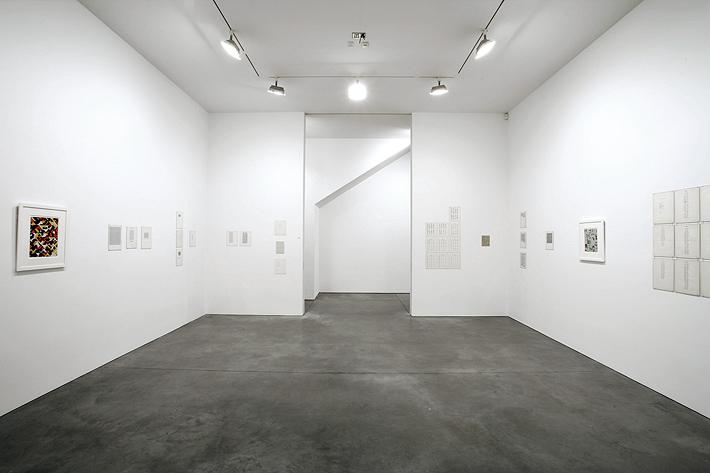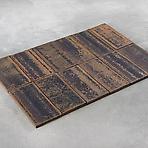Carl Andre
Early works on paper 1958 - 1966
March 16 – June 9, 2007
Gallery 2
We are delighted to present an important group of early Carl Andre poems, collages and other works on paper from 1958 - 1966. Andre's poetry has been actively shown within the context of his other work and included in monographs from the 1960s onward. The majority of similar material from this period is owned by the Stedelijk Museum, Amsterdam and the Chinati Foundation in Marfa, Texas so this exhibition is a unique opportunity to experience such work in New York.
Researching this material has been enriching particularly in light of the gallery's commitment to understanding contemporary art through the filter of historic works (most specifically following our 2005 exhibition Looking at Words: the Formal Use of Text in Modern and Contemporary Works on Paper). This concentrated experience has revealed to us how much this work reflects current ideas in contemporary art. It has also been an extraordinary resource in understanding the visual language of Andre's work in its totality. Though early in date, the included work physically reveals its direct relationship with his sculpture - illuminating ideas about both form and content. These works challenge our approach to reading by using words as particles that when put together emerge as form. Andre recently said to us that while poetry is often considered to be prose put through the filter of music, he considers his poems to be words put through the filter of abstraction.
In interacting with the work over a significant period of time, we felt that that the most compelling way to structure the exhibition was to expose the common threads that run throughout this material: formal constructs such as grids/fields, verticality, pictorial imagery, and repetitive sequences; content such as color as subject, element as subject, interest in early American history (particularly that of Massachusetts), discourse about other artists and art; and relationships to the history of poetry.
Included in Andre's catalogue from his show at the Haags Gemeentemuseum Hollis Frampton states, "Carl Andre and I met as schoolboys. We were interested in science and art. It was customary at the time for young men with diffuse artistic intentions to fancy themselves poets: accordingly, we both were poets."
Reacting against Clement Greenberg's declaration that the trajectory of modernism was to flatten the medium to a purely visual surface, minimalist artists took control of the critical discourse. Through published essays and manifestos, artists emphasized the sensory experience of the primary elements of their works. As artists' writing became more significant, the distinction between sculpture, painting and language blurred. While his colleagues used a prose style of writing to explain and encourage a new literality in art, Carl Andre rebelled against the dominance of structured language by focusing on the "objecthood," the essential property, of a word or a letter. By tearing up the roots of what he called the "prevailing order of language," Andre succeeded in developing a criticism that was not divorced from its object.
Andre's invocation of other artists, poets and critics: Frank Stella, Hollis Frampton, Eugene Goossen, Ralph Waldo Emmerson, Hart Krane, and Willem de Kooning, among others, speaks to the scholarly and collaborative atmosphere in New York in the early 1960s. Around the same time Andre and Frampton met weekly to discuss their ideas on art, literature, poetry and other topics using the mechanical medium of a typewriter. Their communication was published in 1981 in the book 12 Dialogues. Andre's relationships with other artists had a reciprocal effect on the theoretical and practical developments across their work.
In 1959, when Frank Stella was working on his "black" paintings, he invited Andre to work in his studio. In the studio, Andre made one of his first sculptures, Last Ladder (1959), a found 7-foot length of timber in which he cut recessed impressions. Stella pointed out how the uncut surfaces of the timber were also sculpture, which led Andre to explore the essential qualities of an object by dissolving the connection between symbol and referent. Although the sculpture is what it is, the recessed cuts suggest a figurative space representing the rungs on a ladder. Similarly, Andre's poems evolved from lyrical to literal forms. In his vertical poems, Andre experimented with form and the disruption of language by taking words from their common architectural orientation (horizontal lines that read left to right) and re-ordering them to create a new system of reading; the words are stacked on top of each other as individual particles, but still construct a readable sentence. It was in his sculpture Pyramid (1959) where the figurative was erased by the method of stacking identical wood segments in a repetitive form, which like Frank Stella's "black" paintings appeared as if the process had been simply mechanical. Andre has described Stella's method as "neutralizing gesture" by using uniform, identical and repetitive brush strokes thereby transforming the ground of the canvas into "a field of the painting." In this manner, through the mechanism of the typewriter, Andre was able to experiment with his own repetition and uniformity in creating patterns, girds, and modular squares of words. The words, like his sculptures, have a mechanical quality but through interaction with the work the text becomes an immersive experience.
Andre's relationship with poetry did not exist in a vacuum. The connection between writing and art can be traced throughout the first half of the 20th century where poetry was an important medium for artists. Poets such as, Gertrude Stein, E.E. Cummings and Ezra Pound all experimented with syntax, rhythm and repetition and in turn influenced the art created around them. The interplay between art and poetry ricochets through Dada, Surrealism, Constructivism, and Futurism. In the 1950's and 1960's with Fluxus and Concrete Poetry, artists creating poetry as their work instead of merely being influenced by it was at its height. Although the works in this show represent Andre's textual oeuvre from 1958-1966, he continued to write poetry well into the 1970s.
As a child Andre witnessed the joy his father, a Swedish immigrant, experienced upon discovering new words in English. His childhood home was filled with his mother's own amateur poems and he spent evenings on his father's lap reading traditional English poetry. It was through these experiences that Andre developed an appreciation for the individuality of words and unearthed what he describes as a "quarry" of materials. Drawing on his own history, poems he admired, and historic texts, he used words as found objects and rearranged them in poems such as Quincy Bay and Harper's Map. Echoes of Andre's sculptures can be discerned in his poetry - created by the arrangement of the words on the page, the shape of the words together, the individuality of the words, and the space in between. But which way do the echoes reverberate? Is the poetry in the sculpture or the sculpture in the poetry? Since Andre has collapsed traditional language structures, he has ensured that these questions are unanswerable, but are also essentially part of the experience that continues to resonate.
Andre explains that he considers a road to be the ideal sculpture, because like Brancusi's Endless Column (1926), which appeared to continue indefinitely in vertical space, a road achieves the same boundless quality but on a horizontal plane. In the same way, through his work Andre encourages us to set on a journey to new interactions with language, art and society; encouraging us to understand our environment through its granularity and to carry those experiences with us, always engaging, always learning, always unfolding.
"you change and unfold if you truly perceive" - Carl Andre






